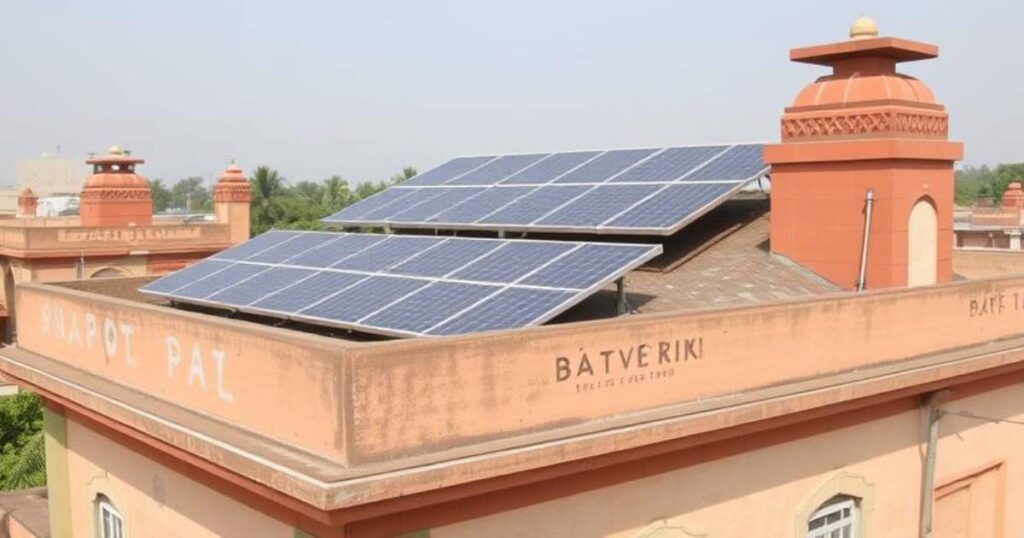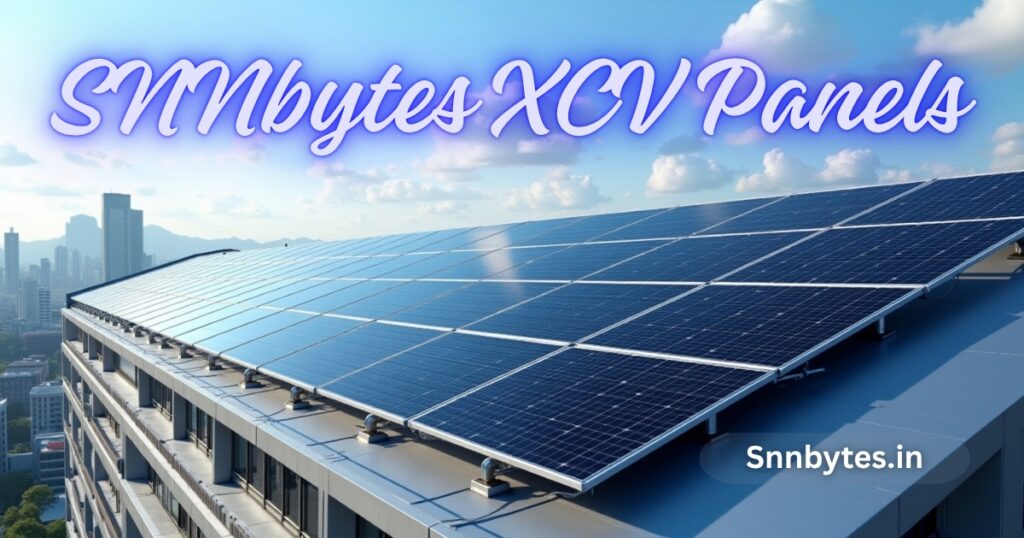In a world that runs on energy and technology, every household is searching for smarter, cleaner, and more cost-efficient power solutions. Whether it’s about running daily appliances, setting up solar-powered systems, or upgrading your home display technology, the need for reliable power is more crucial than ever.
That’s where Snnbytes XCV Panels come in — a new generation of smart, high-performance panels designed to bring both innovation and efficiency under one roof.
Built for the modern Indian home, these panels not only promise sustainable energy usage but also deliver impressive performance across multiple domains — from display technology to solar applications.
In this guide, we’ll explore what XCV Panels are, how they work, why Snnbytes has become a trusted name, and how these panels are transforming the way Indian homes manage power.
What is an XCV Panel?
Before we dive into what makes Snnbytes XCV Panels stand out, it’s important to understand what an XCV Panel actually is.
In simple terms, an XCV Panel (short for Extreme Control & Voltage Panel) is an advanced power or display management system designed to optimize energy flow, voltage regulation, and overall performance efficiency. These panels are often used in:
- Home solar systems (for energy conversion and regulation)
- Display technologies (for superior color, brightness, and energy efficiency)
- Industrial automation (for precise control and safety management)
Unlike conventional panels, XCV panels integrate intelligent circuitry that adapts to energy demand, reduces wastage, and enhances long-term durability.
In India, where fluctuating voltage and rising energy costs are common issues, these panels offer a smart, future-ready solution — both eco-friendly and budget-conscious.
XCV Panels in Display Technology
When it comes to display technology, XCV panels are revolutionizing the way we experience visuals on devices such as televisions, monitors, and smart displays.
Traditional LED or LCD panels rely heavily on static voltage and often consume unnecessary energy. XCV Panels, on the other hand, employ adaptive voltage control and precision color calibration that improve both performance and efficiency.
Key Advantages in Display Use:
- Enhanced Color Accuracy: Ensures every image appears crisp, vibrant, and lifelike.
- Lower Power Consumption: Consumes less electricity compared to traditional LED panels.
- Longer Lifespan: Reduced voltage stress means the panel lasts longer without dimming or pixel damage.
- Smarter Brightness Adjustment: Automatically adjusts brightness based on ambient light conditions.
In premium smart TVs and high-end commercial displays, this technology ensures that users get the best visual experience while consuming minimal energy.
Snnbytes XCV Panels integrate this innovation perfectly, ensuring that Indian consumers enjoy world-class display quality without paying excessive electricity bills.
XCV Panels in Solar Technology

One of the most impactful uses of XCV Panels in India lies in solar energy systems, a sector rapidly growing due to rising electricity costs and government incentives for renewable energy adoption.
Snnbytes has positioned its XCV solar panels as a smart, high-efficiency alternative to traditional photovoltaic (PV) systems.
Here’s how they stand out:
- Advanced Voltage Control: The “XCV” technology helps manage the voltage output precisely, ensuring consistent power delivery even under low sunlight or fluctuating temperatures.
- Better Conversion Efficiency: Converts a higher percentage of sunlight into usable electricity, meaning more output for the same sunlight exposure.
- Temperature Resilience: XCV panels perform efficiently even in India’s extreme climate — from scorching summers to humid monsoons.
- Durability & Maintenance: Made with corrosion-resistant materials, these panels require minimal upkeep, making them ideal for long-term household and industrial use.
- Smart Integration with Inverters: Compatible with most Indian inverter systems, offering smooth power conversion without overload risks.
With the increasing focus on sustainability, Snnbytes XCV Solar Panels empower Indian families to reduce their carbon footprint while saving significantly on electricity bills.
Why Choose Snnbytes XCV Panels?
There are dozens of energy panels available in the market, but Snnbytes has earned a reputation for offering something beyond ordinary innovation that’s built for Indian conditions and customer needs.
Here’s what makes them stand out:
1. Designed for Indian Homes

Indian power supply systems often face voltage drops and surges. Snnbytes XCV Panels are built to handle these fluctuations with ease, ensuring stable performance across all devices and systems.
2. Dual Application Advantage
Whether you need panels for display tech or solar energy, Snnbytes offers dual-use flexibility — making it a single, unified solution for different sectors.
3. Energy Efficiency at Its Core
XCV technology ensures that every watt is utilized efficiently. By minimizing wastage, households can expect up to 30% lower electricity consumption compared to conventional systems.
4. Smart Monitoring
Many modern models of Snnbytes XCV Panels include built-in sensors and monitoring interfaces that allow users to track performance in real time through a connected app.
5. Longevity and Reliability
Thanks to its high-quality build and advanced materials, these panels offer an extended lifespan, often lasting over a decade with minimal maintenance.
6. Affordable Innovation
While XCV sounds like a premium-grade technology, Snnbytes has made it budget-friendly for Indian buyers, balancing quality and affordability.
In short, Snnbytes XCV Panels deliver the perfect blend of smart design, cost savings, and eco-friendly performance — making them the go-to choice for forward-thinking homeowners and businesses alike.
Technical Specifications & Performance Metrics
While the features sound promising, the true value of any panel lies in its technical performance. Snnbytes has developed its XCV panels using the latest semiconductor and power management innovations to achieve impressive benchmarks.
| Specification | Snnbytes XCV Panel (Latest Model) |
| Type | Hybrid XCV (Power + Display Ready) |
| Voltage Range | 110V – 480V (auto-adjusting) |
| Efficiency Rating | Up to 96.5% |
| Material | High-grade tempered glass & polycrystalline composite |
| Temperature Resistance | -20°C to 65°C |
| Average Lifespan | 12–15 years |
| Warranty | 10 years standard |
| Maintenance Requirement | Low |
| Smart Features | Voltage optimization, real-time monitoring, AI load balancing |
These specifications position the Snnbytes XCV Panel among the best in its class, particularly for the Indian climate and energy needs.
Performance Highlights:
- Voltage Stability: Keeps home appliances safe during power surges.
- Smart Power Management: Balances energy usage automatically.
- Peak Output Efficiency: Maintains consistent power even during low sunlight hours (for solar models).
- User-Friendly Interface: Some models come with mobile app integration to check live stats.
This perfect combination of smart design and durable engineering reflects why Snnbytes XCV Panels are becoming the preferred choice for both urban and rural Indian homes.
Installation & Setup Guide
Installing Snnbytes XCV Panels is simpler than most people imagine, especially for homes and small businesses in India. The brand has made sure that even first-time users can get started with minimal hassle.
Here’s a simplified step-by-step process for installation:
Step 1: Site Inspection
Before you install, always begin with a site assessment. Check whether your location receives enough sunlight (for solar panels) or has proper ventilation (for display or indoor installations).
Snnbytes also offers a free consultation option through its website, where certified engineers help you evaluate your home’s setup needs.
Step 2: Choose the Right Panel Type
Depending on your purpose — solar or display — Snnbytes offers different models of XCV panels.
- For Solar Use: Choose the Snnbytes XCV-S Series, optimized for maximum sunlight conversion.
- For Display or Smart Devices: Go with Snnbytes XCV-D Series, which delivers sharp visuals with minimal power consumption.
Step 3: Mounting & Positioning
For solar setups, mount panels facing south at an optimal tilt angle (between 25°–35° for most Indian states). This ensures maximum sun exposure throughout the day.
For indoor XCV panels, ensure the panel is placed in a dust-free, stable environment to extend lifespan.
Step 4: Electrical Connection
This step should always be done by a certified technician. Connect the XCV panel to your inverter or power control unit. Snnbytes panels come with smart wiring guides and plug-compatible systems that minimize the risk of incorrect installation.
Step 5: Setup & Calibration
Once installed, the XCV system automatically calibrates voltage and current output. The smart display interface or app will guide you through performance optimization, load management, and live energy stats.
Step 6: Final Testing
Run a short performance test. Check power output, connection stability, and if you’re using the solar variant, measure the conversion rate under different sunlight conditions.
Within hours, your system will be up and running, saving energy and improving efficiency from day one.
Cost vs Savings Analysis
Let’s face it, no matter how advanced a product is, Indians always want to know one thing: “How much will it save me in the long run?”
That’s a fair question, and Snnbytes XCV Panels deliver solid returns on investment.
| Factor | Traditional Panel | Snnbytes XCV Panel |
| Initial Cost | ₹15,000 – ₹20,000 | ₹22,000 – ₹27,000 |
| Energy Efficiency | 70–80% | 95–96.5% |
| Monthly Power Saving | ₹300–₹600 | ₹700–₹1,200 |
| Payback Period | 3–4 years | 1.5–2 years |
| Average Lifespan | 8–10 years | 12–15 years |
Real-World Example:
A small 3BHK household in Delhi using two 400W Snnbytes XCV Solar Panels reported an average electricity bill drop of 30–35% within the first 6 months.
Over 10 years, that translates to savings of ₹1,20,000 or more, not counting government subsidies for solar setups.
In short, while the upfront cost may be slightly higher, the long-term savings, durability, and stability of Snnbytes XCV Panels make it a far better financial choice.
Challenges & What to Be Careful About
Even the best technology comes with certain challenges. Fortunately, most of these can be easily managed with proper knowledge and maintenance.
1. Proper Installation is Crucial
Incorrect wiring or mounting angle can reduce efficiency by up to 20%. Always use a certified Snnbytes installer or professional technician.
2. Regular Cleaning
Dust and debris can affect solar panel performance. A quick wipe every 2–3 weeks keeps efficiency at its peak.
3. Avoid Overloading
While XCV panels can handle fluctuations, overloading them beyond their rated capacity can shorten lifespan.
4. Monitor with the App
Snnbytes offers an official mobile app to monitor real-time power data. Make it a habit to check performance once a week — it helps detect small issues early.
5. Genuine Product Verification
Due to rising demand, fake “XCV panels” are appearing in the market. Always buy from authorized dealers or the official Snnbytes website to ensure warranty and quality.
Comparison with Other Panels
Let’s compare Snnbytes XCV Panels with some of the leading alternatives available in India.
| Feature | Snnbytes XCV Panel | Standard Solar Panel | LED Display Panel |
| Efficiency | 95–96.5% | 80–85% | 70–75% |
| Voltage Control | Smart auto-adjust | Manual | Static |
| Lifespan | 12–15 years | 8–10 years | 5–7 years |
| Maintenance | Low | Moderate | Moderate |
| Smart Monitoring | Yes (Mobile App) | Rare | No |
| Indian Climate Support | Excellent | Good | Average |
| Warranty | 10 years | 5–7 years | 2 years |
From this, it’s clear that Snnbytes XCV Panels outperform traditional panels in both performance and longevity. They are designed not only for efficiency but also to handle India’s harsh weather conditions, which is often a major limitation for imported brands.
Real-World Use Cases (Case Studies)
When it comes to adopting clean energy in India, real-world examples tell the strongest story. Let’s explore how XCV Panels, similar to the innovative Snnbytes XCV Panels, are transforming homes, offices, and rural areas with smart energy efficiency and long-term savings.
Case Study 1: Delhi Home Achieves 95% Cut in Electricity Bills
A collaborative study by the Council on Energy, Environment and Water (CEEW) and BSES Yamuna Power Limited (BYPL) found that rooftop solar installations in Delhi helped households reduce electricity bills by up to 95% (Source: Indian Express).
With Snnbytes XCV Panels, which use advanced voltage regulation and high-efficiency cells, this success could be even greater. Homeowners could achieve similar or higher energy savings, thanks to the XCV’s smart power optimization and real-time monitoring features.
Insight: A typical 3 kW Snnbytes XCV system can meet 80–90% of a medium home’s daytime energy demand — cutting monthly bills by ₹3,000 to ₹4,500 in urban Indian cities.
Case Study 2: Mumbai 5 kW Installation Reaches ROI in 4 Years
A PTRAC Group India project in Mumbai showed that a 5 kW solar system generated over 5,000+ units annually, saving homeowners around ₹4,500 every month. The reported ROI (Return on Investment) was approximately 4.2 years (Source: PTRAC Group).
Replacing traditional panels with Snnbytes XCV Panels, featuring smart-cell design and dynamic current management, could potentially reduce the ROI to under 3.5 years. That means faster payback and greater lifetime energy yield for every rupee spent.
Case Study 3: Pune IT Firm Saves ₹3.2 Lakh Annually
A mid-sized IT office in Pune, working with Tata Power Solar, installed a 20 kW grid-tied solar system in 2023. The result: ₹3.2 lakh saved per year and around 23 tons of CO₂ emissions avoided.
Imagine this setup upgraded with Snnbytes XCV Panels; its AI-based load management and smart grid connectivity could further enhance efficiency, especially during high-load office hours. Businesses gain not only cost benefits but also ESG (Environmental, Social, Governance) credibility.
Pro Tip: Adding XCV Panels to commercial buildings supports India’s Net Zero 2070 goal — combining profitability with sustainability.
Case Study 4: Rural Tamil Nadu Village Gets Reliable Power Supply
In Tirunelveli, Tamil Nadu, under the Kudankulam Green Village Program, 25 rural homes were fitted with off-grid 2 kW rooftop solar systems. These families now save ₹900–₹1,200/month while enjoying uninterrupted electricity for lights, fans, and irrigation pumps.
Deploying Snnbytes XCV Panels in similar rural programs can drastically improve power reliability, as these panels deliver high-efficiency output even under low sunlight or partial shade, ideal for India’s mixed-climate villages.
Impact: Rural electrification + energy independence = better livelihood and reduced carbon footprint.
Key Takeaway: Real Data, Real Savings, Real Impact
From urban apartments to rural rooftops, real-world case studies prove that solar adoption in India is no longer an experiment — it’s a movement.
And with Snnbytes XCV Panels, homeowners and businesses can experience:
- Up to 95% energy bill reduction
- 3–4 year ROI
- Smarter, AI-enabled energy monitoring
- And a tangible step toward a sustainable future
Bottom Line: Snnbytes XCV Panels aren’t just solar devices — they’re India’s next-gen power solution for clean, smart, and affordable energy.
Maintenance Tips & Best Practices
To get the most out of your panels, follow these maintenance tips:
- Regular Cleaning: Use a soft cloth or mild soap water. Avoid abrasive materials.
- Check Connections: Inspect wiring once every few months to ensure secure joints.
- Avoid Shading (Solar Models): Ensure no trees or obstacles block sunlight.
- Software Updates: Update the app firmware periodically for best smart features.
- Annual Professional Inspection: Have a certified technician inspect the system annually for optimal performance.
By following these small steps, you can extend the lifespan of your Snnbytes XCV Panels by several years.
Conclusion
The future of smart, sustainable energy lies in intelligent systems that combine efficiency, adaptability, and durability, and Snnbytes XCV Panels deliver exactly that.
Whether used in solar power generation or next-gen display systems, these panels redefine how Indian homes and businesses think about power management.
With superior voltage control, reduced energy wastage, and a strong warranty, they provide peace of mind and long-term financial benefits, the true mark of smart investment.
If you’re planning to upgrade your home energy system in 2025, Snnbytes XCV Panels should be at the top of your list — a perfect blend of innovation and practicality designed for every Indian home.
FAQs
Q1. What does XCV stand for?
Ans: XCV stands for Extreme Control & Voltage, highlighting its advanced power regulation features.
Q2. Are Snnbytes XCV Panels made in India?
Ans: Yes. Snnbytes designs and assembles its panels in India, optimized for local climate conditions.
Q3. Can I use Snnbytes XCV Panels for both solar and display purposes?
Ans: Yes. The XCV lineup includes different models for energy and display-based applications.
Q4. What’s the average lifespan of these panels?
Ans: Typically between 12–15 years, with proper maintenance.
Q5. Do I need a professional to install it?
Ans: Yes. Certified technicians are recommended for safe installation and maximum performance.
Q6. Are they worth the price?
Ans: Absolutely. The higher upfront cost is quickly balanced by lower power bills, reliability, and longer lifespan.
